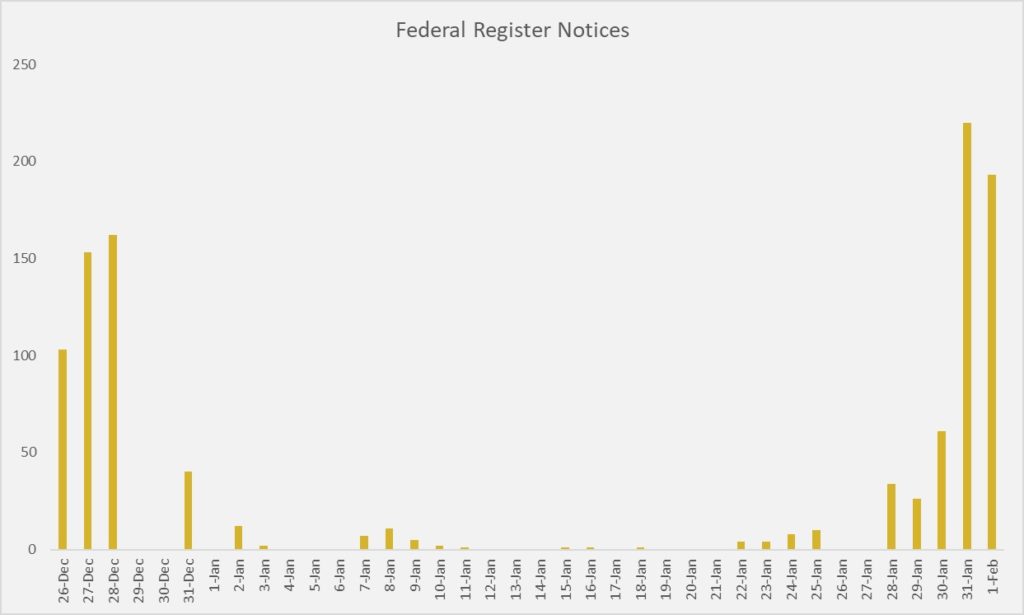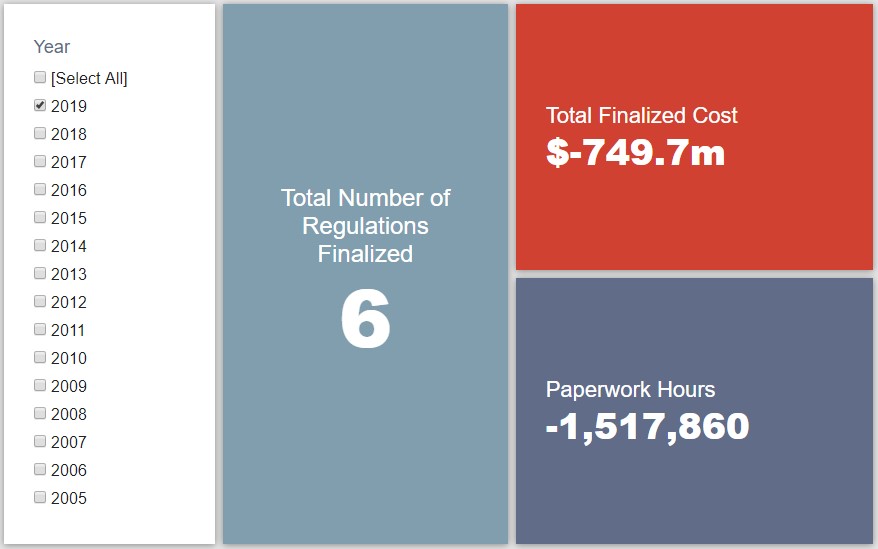Week in Regulation
February 4, 2019
2019’s First Net-Cost Week
As both January and the recent partial government shutdown came to a close, 2019 had its first week in which rulemakings produced net costs. This is mainly due to a proposed rule from the Securities and Exchange Commission. In terms of final actions, however, there was still a cost reduction trend. Between both proposed and final rules last week, agencies published $403.2 million in net costs, but reduced paperwork burdens by 3.4 million hours.
REGULATORY TOPLINES
- New Proposed Rules: 31
- New Final Rules: 34
- 2019 Total Pages: 1,332
- 2019 Final Rule Costs: -$749.7 Million
- 2019 Proposed Rule Costs: $1.1 Billion
TRACKING THE REGULATORY BUDGET
The most notable final rule affecting the fiscal year (FY) 2019 “regulatory budget” under Executive Order (EO) 13,771 comes from the Department of Homeland Security (DHS). The rule adds a registration requirement to H-1B visa petitions aiming “to increase the odds of selection for H-1B beneficiaries who have earned a master’s or higher degree from a U.S. institution of higher education.” Despite making a program more stringent and adding a new requirement, DHS has deemed this a deregulatory action. Its rationale? This new requirement serves as a screening mechanism and thus saves certain petitioners the “opportunity cost” of completing an ultimately futile petition for a H-1B visa. The agency calculates that those savings could accrue to $626 million over 10 years. The reduction in the respondent pool cuts roughly 1.4 million hours of paperwork attributable to this program.
So far in FY 2019 (which began on October 1, 2018), there have been 26 deregulatory actions (per the rubric created EO 13,771 and the administration’s subsequent guidance document) against nine rules that increase costs and fall under the EO’s reach. Combined, these actions yield quantified net costs of roughly $615 million. This, however, includes the caveat regarding the baseline in the Department of Agriculture’s “National Bioengineered Food Disclosure Standard.” If one considers that rule to actually be deregulatory, the administration-wide net total is approximately $6.1 billion in net savings. The administration’s cumulative savings goal for FY 2019 is approximately $18 billion.
THIS WEEK’S REGULATORY PICTURE
One can describe “regulatory policy” in many ways: mundane, opaque, monotonous, complex, legalistic. The list goes on. In order to help provide a clearer and more straight-forward view into this world, the American Action Forum (AAF) will seek to provide a brief illustration of a notable regulatory trend we have identified in a given week. This week’s entry: the “shutdown swoon” in basic administrative tasks and the subsequent need to catch up.
As AAF has noted over the past few weeks, the now-concluded partial government shutdown saw a historic slowdown in regulatory activity. This graph provides a frame of reference on just how dramatic that period has been as compared to more typical times. “Notices” are documents published in the Federal Register that do not necessarily rise to the level of “regulations.” They are often announcements of meetings and hearings surrounding certain rules or certifications of certain sub-regulatory items such as paperwork requirements.
The first few days of the shutdown saw a fairly typical level of output (as there is a lag between documents getting submitted to the Federal Register and their actual publication), but then it dropped off a cliff for the next month. The tail-end of last week saw a somewhat above-average increase in notice volume. The post-shutdown spike is largely from agencies playing catch-up. Since a shutdown period ceases all but the most “essential” activities from agencies, some mundane items like meetings with stakeholders get postponed. The subsequent increase comes from a natural back-log in how many new meeting announcements agencies need to publish. From rulemaking on down to some of the most routine administrative housekeeping, the shutdown’s impact will continue to reverberate through the regulatory process.
TOTAL BURDENS
Since January 1, the federal government has published $319.5 million in net costs (with $749.7 million in finalized savings) and 3.5 million hours of paperwork burden reductions (including roughly 1.5 million fewer hours from final rules). Click here for the latest Reg Rodeo findings.












